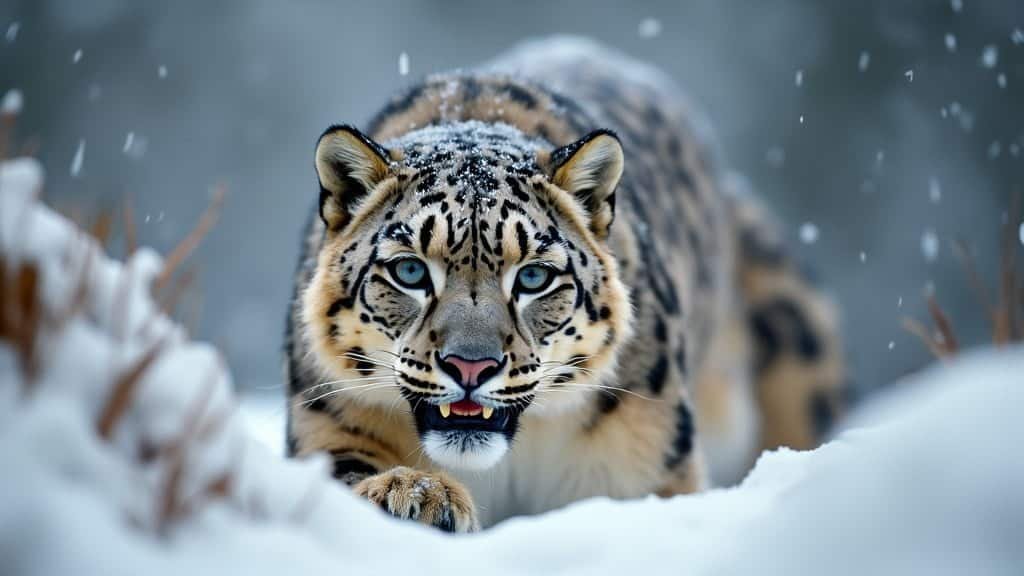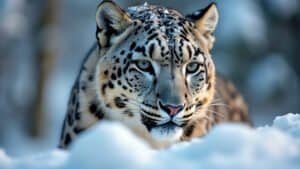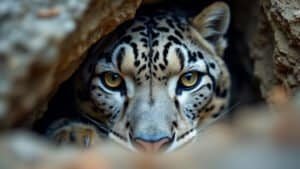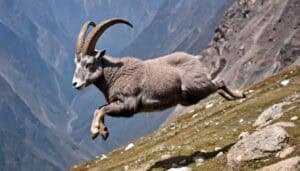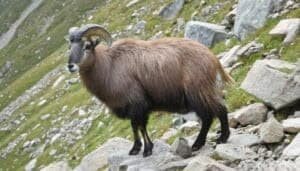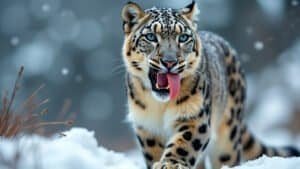Introduction
Snow leopards, known for their elusive nature and majestic presence in the high-altitude regions of Central Asia, exhibit fascinating differences in their diets based on gender. These dietary differences are influenced by factors such as prey availability, reproductive needs, and territorial behavior
In this article, we will explore the specific prey preferences of male and female snow leopards, examine their unique nutritional requirements, and delve into the distinct hunting strategies each sex employs
Understanding these differences provides valuable insight into the survival strategies and ecological roles of these incredible predators
Prey Preferences of Male Snow Leopards
Male snow leopards, known for their larger size and more extensive territories, often exhibit distinct prey preferences that align with their physical capabilities and ecological roles
These preferences are shaped by a combination of factors, including the availability of prey within their territory, competition with other predators, and the energy needs required to sustain their larger bodies
Common Prey Species for Males
Male snow leopards tend to target larger prey species that provide more substantial nutritional benefits. Among their favored prey are animals such as blue sheep (bharal), Himalayan tahr, and ibex. These ungulates are abundant in the rugged, mountainous regions where snow leopards thrive, making them a primary food source
Research conducted by the Snow Leopard Trust and other conservation organizations has consistently shown that these large prey items make up a significant portion of the male snow leopard’s diet
In addition to large ungulates, male snow leopards also hunt smaller mammals, birds, and occasionally even livestock, particularly in areas where human-animal conflict is prevalent. The choice of prey often depends on seasonal availability, with males showing flexibility in their diet when preferred prey is scarce.
Hunting Larger Prey: Strategies and Benefits
Hunting larger prey presents both challenges and advantages for male snow leopards. The primary benefit is the higher caloric intake from a single kill, which can sustain the leopard for several days
This is crucial for males, who must patrol and defend vast territories, often requiring significant energy expenditure. To take down large prey, male snow leopards rely on their strength, stealth, and the element of surprise
They often use the mountainous terrain to their advantage, ambushing prey from above or stalking them over long distances before launching a powerful attack
However, hunting larger prey is also risky. The prey animals are often formidable, with strong defenses such as horns or the ability to flee to steep, inaccessible cliffs. This requires the male snow leopard to be highly strategic, carefully selecting moments to strike when success is more likely
Studies have shown that male snow leopards may spend several days tracking and observing a potential target before making a move
Influence of Territory and Prey Availability
The size and quality of a male snow leopard’s territory play a significant role in determining its diet. Larger territories, often held by dominant males, typically contain a more diverse range of prey species, allowing for a more varied diet
Males with smaller or less productive territories may be forced to hunt smaller prey more frequently or even venture into human-inhabited areas, increasing the risk of conflict
Prey availability is also closely linked to seasonal changes. During harsh winters, when prey becomes scarce, male snow leopards may travel greater distances in search of food, sometimes crossing into the territories of other males, leading to potential confrontations
The ability to adapt to these fluctuations is critical for survival, and males that can efficiently exploit available resources are more likely to thrive
Prey Preferences of Female Snow Leopards
Female snow leopards, while generally smaller than their male counterparts, exhibit unique prey preferences influenced by their role in reproduction and rearing cubs
Their dietary habits are shaped by the need to balance energy intake with the demands of pregnancy, lactation, and caring for their young. This often leads to differences in the size and type of prey they target compared to males
Typical Prey Choices for Females
Female snow leopards often opt for smaller prey compared to males, though they are capable of hunting larger animals when necessary. Common prey for females includes species such as marmots, pikas, and smaller ungulates like young blue sheep or Himalayan tahr
These smaller animals are abundant in their habitat and provide a reliable food source that requires less energy to hunt and kill
During the breeding season or when caring for cubs, female snow leopards may prioritize prey that is easier to catch and carry back to their dens. This ensures they can provide for their offspring while minimizing the risk and energy expenditure involved in hunting larger, more dangerous prey
Studies have shown that female snow leopards with cubs are more likely to hunt frequently, targeting smaller prey that can be consumed quickly or cached for later use
Impact of Reproductive Needs on Diet
Reproductive responsibilities significantly influence the dietary habits of female snow leopards. Pregnant and lactating females have higher nutritional needs, requiring a steady intake of calories and essential nutrients to support both themselves and their growing cubs
This need drives them to hunt more frequently, often focusing on prey that is readily available and poses less risk during capture
The diet of a female snow leopard during pregnancy and while nursing can also affect the health and survival of her cubs. A diet rich in protein and fats is crucial for producing nutrient-rich milk, which is vital for the development of the cubs in their early stages of life
Consequently, females may exhibit more opportunistic hunting behaviors during these periods, sometimes even venturing into areas closer to human settlements where smaller, easier prey like livestock may be available
Smaller Prey: Why Females Hunt Differently
The preference for smaller prey among female snow leopards is not merely a matter of physical size but also of strategy
Smaller prey animals are typically easier to catch, handle, and transport, which is especially important when a female needs to feed cubs or when she must conserve energy for future hunts. The act of hunting smaller prey reduces the risk of injury, which is critical for a female that must remain healthy to care for her young
Moreover, the choice of smaller prey is often dictated by the need for quick and efficient hunting. Female snow leopards, particularly those with cubs, may need to hunt and return to their dens swiftly to avoid leaving their offspring vulnerable to predators
The ability to successfully capture smaller prey with minimal effort and risk is a key survival strategy that supports both the female and her cubs during critical stages of their lives
Nutritional Needs and Dietary Differences
The nutritional needs of male and female snow leopards are shaped by their respective roles and biological demands, resulting in notable differences in their diets
While both sexes require a balanced intake of proteins, fats, and other essential nutrients, the specific needs vary based on factors such as body size, reproductive status, and energy expenditure
Comparing Caloric Intake Between the Sexes
Caloric intake is a crucial factor in understanding the dietary differences between male and female snow leopards
Males, being larger and more muscular, generally require a higher caloric intake to sustain their body mass and to meet the energy demands of patrolling large territories and defending them from rivals. This need drives them to hunt larger prey that provides a greater caloric yield per kill
Studies have indicated that an adult male snow leopard might require around 3,000 to 4,000 calories per day, depending on the season and activity level. In contrast, females, especially those that are pregnant or nursing, may have slightly lower but more frequent caloric requirements
Their intake needs to support both their own energy needs and the additional demands of cubs during lactation. The energy-rich diet of a female is crucial during this period, as it directly impacts the health and growth of her cubs
Protein and Fat Requirements
Both protein and fat are essential components of the snow leopard’s diet, providing the necessary building blocks for muscle maintenance, energy, and overall health. However, the proportion and sources of these nutrients can differ between males and females based on their prey choices and physiological needs
Male snow leopards, who often hunt larger prey, typically consume higher amounts of protein and fat from animals such as ibex and blue sheep
These prey animals offer a rich source of these nutrients, which are critical for maintaining the male’s larger muscle mass and supporting his active, territorial lifestyle
The high fat content in larger prey also provides a valuable energy reserve, particularly during the cold winter months when energy demands are highest
For females, particularly those who are pregnant or nursing, the balance of protein and fat intake becomes even more critical. A diet that is rich in protein supports the growth and development of the cubs, both in utero and during the early stages of life. Fat, on the other hand, is essential for producing high-quality milk that can sustain the cubs during their first few months
Consequently, females may prioritize prey that offers an optimal balance of these nutrients, even if it means hunting more frequently or targeting different prey species than males
Role of Diet in Reproduction and Survival
The diet of snow leopards plays a significant role in their reproductive success and overall survival. For males, a nutrient-rich diet is essential for maintaining the strength and stamina needed to defend territory, mate, and compete with other males
A diet deficient in essential nutrients can lead to reduced physical condition, making it harder for males to secure and hold territory, ultimately impacting their ability to reproduce
For females, the diet directly influences reproductive outcomes, from successful conception to the health of the cubs after birth. A poor diet can lead to lower birth weights, reduced milk production, and higher mortality rates among cubs
Additionally, the nutritional status of the female during pregnancy affects her ability to care for and protect her cubs, making a balanced and nutrient-rich diet critical during this time
In the broader ecological context, the diet of both male and female snow leopards also impacts their ability to adapt to changing environmental conditions, such as shifts in prey availability due to climate change or human encroachment
Snow leopards that can adjust their diets to include a wider variety of prey are more likely to survive in the face of these challenges, ensuring the continued survival of their species in a rapidly changing world
Hunting Strategies and Techniques
The hunting strategies and techniques employed by male and female snow leopards reflect their physical differences, reproductive roles, and territorial behaviors. These strategies are essential for ensuring successful kills, which directly affect the survival and health of these elusive predators
Male vs. Female Hunting Methods
Male and female snow leopards exhibit distinct hunting methods tailored to their physiological and ecological needs. Males, with their larger size and strength, are more likely to pursue and take down larger prey
Their hunting strategy often involves stalking their prey over long distances, using their superior strength to overpower it once they are within striking distance. Males typically rely on ambush tactics, using the rugged terrain to hide and surprise their prey
The element of surprise is crucial, as the larger prey animals they target, such as ibex and bharal, are often well-equipped to escape or defend themselves
In contrast, females, especially those with cubs, tend to focus on smaller, more manageable prey. Their hunting methods are often more cautious, prioritizing efficiency and the safety of their young. Females may use similar ambush tactics as males but often target smaller prey that requires less energy to subdue
This approach minimizes the risk of injury, which is particularly important for a female who needs to remain healthy to care for her offspring. Additionally, females are more likely to cache food for later use, particularly when hunting in areas where prey is abundant but small in size
Efficiency and Energy Expenditure in Hunting
The efficiency of a hunt and the energy expenditure involved are critical factors in the survival of snow leopards. For males, the pursuit of larger prey is energy-intensive but offers a high reward in terms of caloric intake
A successful hunt can provide enough food to last several days, allowing the male to conserve energy between hunts. However, the risks are also higher, as failed hunts or injuries can lead to significant energy deficits, which can be detrimental in the harsh environments they inhabit
Females, on the other hand, must balance the need to provide for their cubs with the energy costs of hunting. Smaller prey, while offering fewer calories per kill, can be captured with less energy and lower risk
This efficiency is crucial for females, especially when they have young cubs that require constant care and feeding. By targeting smaller prey, females can hunt more frequently and ensure a steady food supply, which is vital for the survival of their cubs
The terrain also plays a significant role in the energy dynamics of hunting. Snow leopards are adept at navigating steep, rocky landscapes, using their powerful limbs and thick tails for balance. This agility allows them to exploit the verticality of their environment, stalking prey from above or chasing it across uneven ground
However, this type of hunting requires significant energy, making it essential for snow leopards to choose their hunting grounds and prey carefully to maximize the chances of success while minimizing energy loss
Seasonal Variations in Hunting and Diet
The hunting strategies and diet of snow leopards can vary significantly with the seasons, reflecting changes in prey availability and environmental conditions
In the harsh winter months, when snow covers much of the terrain and prey becomes scarce, snow leopards may be forced to expand their hunting range or target different species than they do in the warmer months
During winter, both male and female snow leopards may hunt more substantial prey, such as livestock, as wild prey becomes harder to find. This can lead to increased human-wildlife conflict, particularly in regions where snow leopards’ natural prey has been depleted by overgrazing or hunting
The harsh conditions also mean that snow leopards must be more efficient in their hunting, as the energy costs of moving through deep snow and cold temperatures are high
In the spring and summer, when prey such as marmots and pikas are more abundant, females may shift their focus to these smaller animals, which are easier to hunt and provide sufficient nutrition for both themselves and their cubs
Males, too, may adjust their hunting strategies to take advantage of the seasonal abundance of certain prey species, ensuring they can maintain their strength and health throughout the year
The ability to adapt to these seasonal changes is a key survival strategy for snow leopards, allowing them to thrive in one of the most challenging environments on earth. Their flexible hunting strategies and varied diet are crucial for coping with the dynamic and often harsh conditions of their mountainous habitat
Conclusion
The dietary differences between male and female snow leopards are a reflection of their distinct roles within their environment and the unique challenges they face. Males, larger and more territorial, tend to hunt bigger prey that provides the high caloric intake necessary to sustain their energy-demanding lifestyle
Their strategies often involve stalking and ambushing large ungulates in the rugged terrain of the mountains. Females, on the other hand, focus more on smaller prey, especially when they have cubs to care for, balancing the need for efficiency with the safety of their offspring. Their diet is closely tied to reproductive needs, with a greater emphasis on the nutritional quality required to support pregnancy and lactation
Seasonal changes also influence their hunting strategies, requiring both sexes to adapt to the availability of prey throughout the year. Understanding these differences provides deeper insight into the survival strategies of snow leopards, highlighting the delicate balance they maintain in the harsh environments they inhabit
